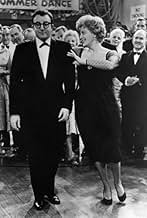Un professeur d'université d'âge mûr s'emballe pour une fillette de quatorze ans.Un professeur d'université d'âge mûr s'emballe pour une fillette de quatorze ans.Un professeur d'université d'âge mûr s'emballe pour une fillette de quatorze ans.
- Nommé pour 1 oscar
- 2 victoires et 9 nominations au total
Terry Kilburn
- Man
- (as Terence Kilburn)
Histoire
Le saviez-vous
- AnecdotesPeter Sellers modeled the voice of his character Clare Quilty on that of his director, Stanley Kubrick.
- GaffesDirector Stanley Kubrick walks out of the very first interior shot (center to right bottom) of Humbert entering Quilty's house.
- Citations
Charlotte Haze: Do you believe in God?
Humbert Humbert: The question is does God believe in me?
- Générique farfeluThe credits are played over footage of Lolita's toenails being painted.
- Autres versionsThe scene where Lolita first "seduces" Humbert as he lies in the cot is a good 10 seconds longer in the British cut of the film. In the U.S. cut, the shot fades as she whispers the details of the "game" she played with Charlie at camp. In the U.K. print, the shot continues as Humbert mumbles that he's not familiar with the game. She then bends down again to whisper more details. Kubrick then cuts to a closer shot of Lolita's head as she says "Well, allrighty then" and then fades as she begins to descend to Humbert on the cot. The British cut of the film was used for the Region 1 DVD release.
- ConnexionsEdited into Hai-Kubrick (1999)
Commentaire en vedette
8/10
Kubrik's version of Nabokov's tale of a middle-aged professor's self-destructive obsession with a young schoolgirl. Making a film that dealt with underage sex was considered impossible in 1962 due to the strict censorship regulations. Kubrik manages to get round this by merely alluding to sexual encounters and subtle wordplay and symbolism creeps into several scenes. He also raises the girl's age from 12 in the novel to 14 in the film. Lolita is also rich in Kubrik's trademark dark humour.
The three central characters of the novel are all portrayed more than adequately in the film; James Mason as the smitten professor, Shelley Winters as the suburban widow with pretensions of culture and Sue Lyons as the young nymphet. However, it is Sellars' performance as the creepy eccentric Clare Quilty (a relatively minor character in the book) that steals the show and, ultimately, makes the film. The opening scene (which is the ending of the film) is an outstanding testament to his talent and versatility. The said scene gives the film the same "circular structure" used by David Lean in "Brief Encounter".
My favourite moments include; Quilty's re-introduction to the film at the school's summer ball as the camera pans across the dancefloor and subtly reveals a look of comic ambivalence on his face as he dances with his lover, Humbert awkwardly trying to book the only remaining hotel-room at the police convention and Humbert again trying to teach the cynical Lolita the joys of Edgar Allen Poe's poetry.
I thoroughly recommend this film. My only complaint is the length - the final third seemed to drag a bit.
Kubrik's version of Nabokov's tale of a middle-aged professor's self-destructive obsession with a young schoolgirl. Making a film that dealt with underage sex was considered impossible in 1962 due to the strict censorship regulations. Kubrik manages to get round this by merely alluding to sexual encounters and subtle wordplay and symbolism creeps into several scenes. He also raises the girl's age from 12 in the novel to 14 in the film. Lolita is also rich in Kubrik's trademark dark humour.
The three central characters of the novel are all portrayed more than adequately in the film; James Mason as the smitten professor, Shelley Winters as the suburban widow with pretensions of culture and Sue Lyons as the young nymphet. However, it is Sellars' performance as the creepy eccentric Clare Quilty (a relatively minor character in the book) that steals the show and, ultimately, makes the film. The opening scene (which is the ending of the film) is an outstanding testament to his talent and versatility. The said scene gives the film the same "circular structure" used by David Lean in "Brief Encounter".
My favourite moments include; Quilty's re-introduction to the film at the school's summer ball as the camera pans across the dancefloor and subtly reveals a look of comic ambivalence on his face as he dances with his lover, Humbert awkwardly trying to book the only remaining hotel-room at the police convention and Humbert again trying to teach the cynical Lolita the joys of Edgar Allen Poe's poetry.
I thoroughly recommend this film. My only complaint is the length - the final third seemed to drag a bit.
- dantbrooks
- 13 août 2003
- Lien permanent
Meilleurs choix
Connectez-vous pour évaluer et surveiller les recommandations personnalisées
Détails
Box-office
- Budget
- 2 000 000 $ US (estimation)
- Brut – à l'échelle mondiale
- 7 411 $ US
- Durée2 heures 33 minutes
- Couleur
- Rapport de forme
- 1.66 : 1
Contribuer à cette page
Suggérer une modification ou ajouter du contenu manquant




































